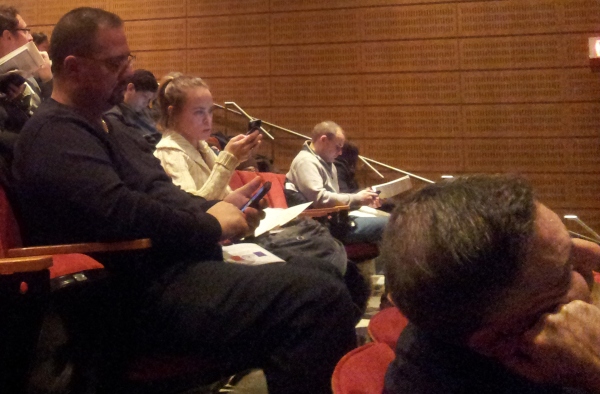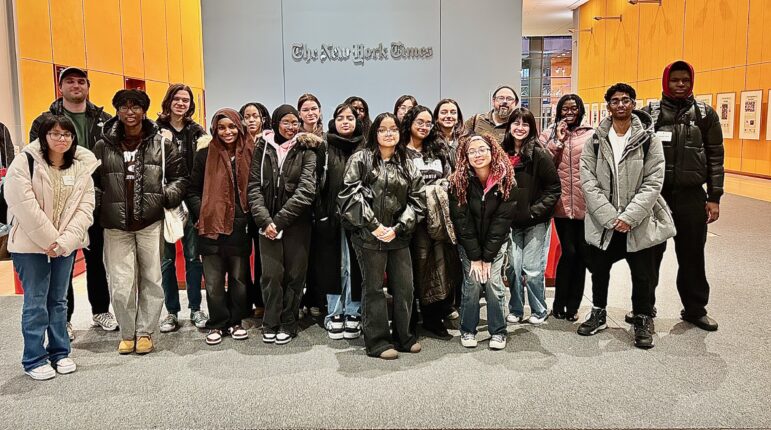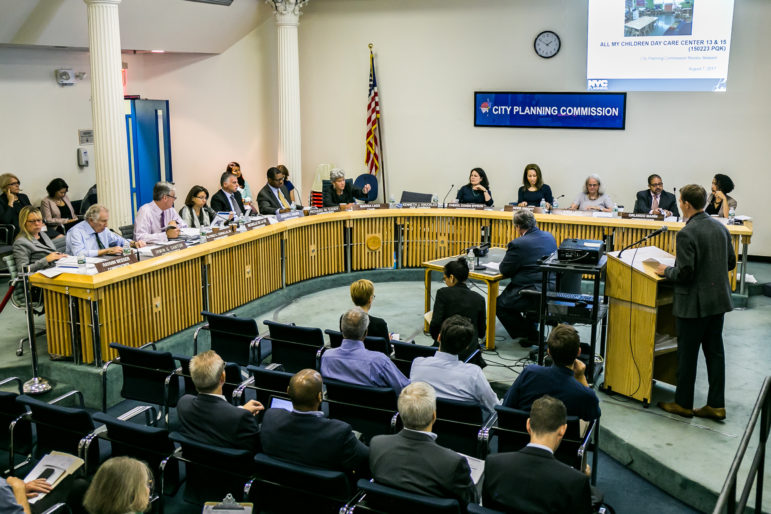
Photo by: Batya Ungar-Sargon
Concerns about disparities in the health system dominated the discussion.
A crowd of about 250 assembled in Long Island University’s Kumble Theater on Wednesday night to hear four of ten invited candidates answer a panel’s questions on issues of public health that will face the next mayor.
In attendance were Republican Tom Allon, CEO of Manhattan Media, and former Councilman Sal, Comptroller John Liu and former Comptroller William Thompson.
Not in attendance were Adolfo Carrion, John Catsimatidis, Bill de Blasio, George McDonald and Malcolm Smith, and the two candidates—Joe Lhota, and Christine Quinn—who are considered front runners in the race; a recent Quinnipiac University polls found Quinn leading Democrats with 35 percent support, and Lhota ahead of other Republicans with 23 percent. But 53 percent of voters are still undecided.
Tom Robbins, former Daily News and Village Voice reporter and current Investigative Journalist in Residence at the CUNY Graduate Center School of Journalism, moderated a series of five questions posed by a panel of doctors and community organizers. “Knowing we’re going to get a new mayor no matter what,” Robbins began, to raucous applause from the audience, “we’re here to hear the ideas of the candidates.”
The questions focused largely on the access to healthcare for low-income and minority communities, but also addressed fears that healthcare is becoming increasingly privatized. The closing of hospitals, the effect of superstorm Sandy on the healthcare system, and healthcare education were also addressed in the panelists’ questions—as were some of the mental health issues raised by two recent subway deaths and the Sandy Hook massacre.
Many of the same ideas recurred in the candidates’ answers, who all agreed that community-based organizations were central components of the healthcare system and could be useful in trying to effectively reallocate funds—city and federal—to make sure that underserved populations get more services.
But subtle differences did emerge between candidates as to how exactly that would be achieved.
For Allon, at stake is the question of accountability. “Community centers are the lynchpin of my healthcare system,” he said, “but until separate elements of public health start working together with better oversight, the system will be plagued by problems unsolved by a piecemeal approach.” For this reason, Allon recommends creating more frontline services to alleviate emergency room congestion resulting from recent hospital closures. Allon wants to see collaboration between the public and the private sector, and with the right oversight, believes that a lot of the resources that are currently available will be freed up. He stressed mental healthcare and the importance of utilizing schools to provide better services, both by targeting students for health education, but also by utilizing the school buildings—which are only being utilized from eight to three—for other community needs; he used this as an example of how thinking like a businessman can be useful in responding to the needs of underserved populations.
Sal Albanese considered it “malpractice” to ignore the needs or the contributions of at-risk communities by reacting to, instead of preparing for crises. He is “committed to funding community organizations as a priority,” he said. Board members from labor and from community organizations have valuable input, said Albanese, who also believes that government should reflect diversity of the city. “There is enough qualified staff from each ethnic background for us to hire a diverse staff. People feel more comfortable when they see people who look like them, especially in hospitals settings.” He also stressed the importance of schools and education for making use of a captive audience to deeply ingrain healthy habits.
William Thompson stressed the need to keep services in the communities they serve. “Bloomberg has moved healthcare out of the communities that need it,” he said. “No one wants to travel to get healthcare.” He would seek to emulate what he called the Cincinnati model, which brings healthcare to schools, for example, testing for childhood diabetes in addition to eye exams. “It’s a question of making it a priority of matching dollars to needs,” Thompson said in response to a question about disparities in health funding across neighborhoods. “Every labor contract in the city of New York will have expired at the end of the year,” he said in response to a question about fiscal cuts. “But no money has been put aside for settlements. If we’re going to make reductions, we need to include vulnerable populations in the conversation.” He applauds Mayor Bloomberg for his “top-down” health initiatives, but says many populations have been ignored, such as the HIV population.
John Liu was “not optimistic that city can make up federal shortfalls,” but added, “community based organizations are very cost effective.” As comptroller, he said, he has sought to reduce amount of bureaucracy that organizations have to deal with in order to free up CBOs. Furthermore, for Liu, “labor unions are very important.” He stressed the point that public health should in no way be privatized, and that strong healthcare is an economic boon with a strong return on the investment. “We have an administration that wants to give a hard time to the unions,” Liu said, claiming in addition that the way an administration deals with the most vulnerable is not a question of dollars but a question of attitude. “Any one in this room could become disabled tomorrow,” Liu said. With today’s technology, it is only a question of attitude that keeps the disabled or the vulnerable from getting the care they need.
Jackie Vimo, director of advocacy for the New York Immigration Coalition and Judy Wessler of the Commission on the Public’s Health System spoke during a break about the dangers facing public health in New York City.
“At the state level, $1 billion has been set aside in what’s called the ‘Indigent Care Pool’. But only 10% of that is going to the uninsured,” Wessler said. “The other 90 percent are currently non accountable. Some goes to the indigent, some to bad debt. Unless we do something about this, we could stand to lose federal funding.”
Vimo explained that this is because the money goes straight to the hospitals, and is not allocated by patient. She added that the money should be going to those without access to healthcare, such as illegal immigrants. And she raised questions about cost-cutting in some health services. “We are saving money,” Vimo said, “but at what cost to the patient?”








